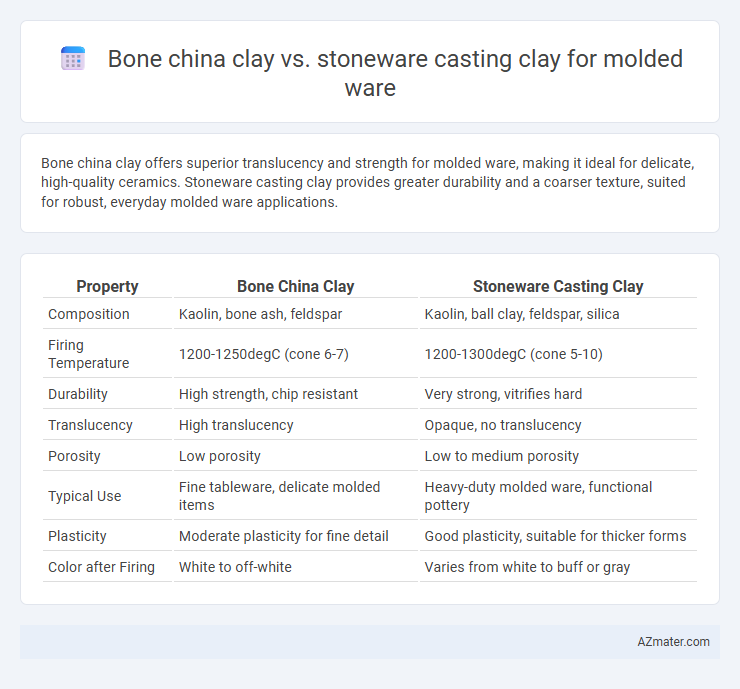Bone china clay offers superior translucency and strength for molded ware, making it ideal for delicate, high-quality ceramics. Stoneware casting clay provides greater durability and a coarser texture, suited for robust, everyday molded ware applications.
Table of Comparison
| Property | Bone China Clay | Stoneware Casting Clay |
|---|---|---|
| Composition | Kaolin, bone ash, feldspar | Kaolin, ball clay, feldspar, silica |
| Firing Temperature | 1200-1250degC (cone 6-7) | 1200-1300degC (cone 5-10) |
| Durability | High strength, chip resistant | Very strong, vitrifies hard |
| Translucency | High translucency | Opaque, no translucency |
| Porosity | Low porosity | Low to medium porosity |
| Typical Use | Fine tableware, delicate molded items | Heavy-duty molded ware, functional pottery |
| Plasticity | Moderate plasticity for fine detail | Good plasticity, suitable for thicker forms |
| Color after Firing | White to off-white | Varies from white to buff or gray |
Overview of Bone China Clay and Stoneware Casting Clay
Bone china clay is a refined porcelain material composed primarily of kaolin, feldspar, and bone ash, offering translucency and high strength ideal for delicate molded ware. Stoneware casting clay contains more grog and feldspar, providing durability, higher firing temperatures, and resistance to chipping, making it suitable for robust molded items. Both clays cater to different functional and aesthetic requirements in molded ware production, with bone china emphasizing elegance and stoneware focusing on sturdiness.
Composition Differences: Bone China vs Stoneware
Bone china clay consists primarily of feldspar, kaolin, and a high percentage of bone ash, which imparts translucency, whiteness, and added strength. Stoneware casting clay is composed mainly of fused quartz, feldspar, ball clay, and fire clay, resulting in a denser, more durable body suitable for functional and decorative molded ware. The distinct presence of bone ash in bone china creates a lighter, more refined texture compared to the more robust, earthy composition of stoneware.
Characteristics of Bone China Clay
Bone china clay is renowned for its high translucency, whiteness, and strength, making it ideal for finely detailed molded ware with a smooth, delicate finish. Its composition, which typically includes bone ash, feldspar, and kaolin, allows for superior vitrification at lower firing temperatures compared to stoneware casting clay. Stoneware clay, conversely, tends to be more durable and less translucent but requires higher firing temperatures, resulting in a denser, more robust product less suitable for delicate molded designs.
Properties of Stoneware Casting Clay
Stoneware casting clay is known for its robust durability and high firing temperature range, typically between 1200degC and 1300degC, which enhances its strength and resistance to chipping. Its dense, non-porous body offers excellent thermal shock resistance, making it ideal for functional molded ware that requires durability and everyday use. Compared to bone china clay, stoneware casting clay has a more rustic, earthy texture and a naturally matte finish, providing versatility in both aesthetic and practical ceramic applications.
Workability in Molded Ware Production
Bone china clay offers superior plasticity and smoothness, enhancing detailed mold replication in molded ware production, whereas stoneware casting clay provides higher strength and durability but can be less pliable for intricate molds. The fine particle size and refined composition of bone china clay improve slip flow and reduce defects during casting, making it ideal for delicate, precise forms. Stoneware clay requires more careful moisture control and longer drying times to prevent warping, which affects overall workability in high-precision molded ware processes.
Firing Temperatures and Shrinkage Behavior
Bone china clay typically fires at higher temperatures ranging from 1200degC to 1250degC, resulting in a translucent and durable finish with around 5-7% shrinkage. Stoneware casting clay fires at lower temperatures, usually between 1100degC and 1150degC, and exhibits less shrinkage, approximately 4-6%, leading to greater dimensional stability in molded ware. The higher firing temperature of bone china requires careful control to prevent warping, whereas stoneware's lower firing range offers more consistent shrinkage rates ideal for functional ceramics.
Strength and Durability Comparison
Bone china clay exhibits higher strength and durability compared to stoneware casting clay due to its unique composition, including bone ash, which enhances translucency and mechanical resistance. Stoneware casting clay is more porous and less refined, resulting in lower strength but greater thermal shock resistance and impact durability in heavy-duty applications. The denser structure of bone china provides superior resistance to chipping and cracking, making it ideal for fine, delicate molded ware, while stoneware's robustness suits utilitarian and outdoor items requiring toughness.
Aesthetic Qualities: Transparency and Surface Finish
Bone china clay offers superior translucency and a delicate, smooth surface finish, making it ideal for finely detailed molded ware with a refined aesthetic. Stoneware casting clay is more opaque with a heavier, matte surface texture, which emphasizes rustic and robust visual qualities. The choice between bone china and stoneware casting clay significantly impacts the visual purity and tactile experience of the finished mold.
Suitability for Intricate Molded Designs
Bone china clay offers superior suitability for intricate molded designs due to its fine particle size and high plasticity, which allow delicate detailing and smooth surfaces. Stoneware casting clay, being coarser and less plastic, struggles to capture fine details but provides greater durability and strength in the final piece. For complex, detailed molded ware, bone china clay consistently delivers enhanced precision and definition.
Cost and Availability Considerations
Bone china clay typically commands a higher price point due to its refined composition and limited natural sources, making it less accessible than stoneware casting clay. Stoneware casting clay is widely available and cost-effective, suitable for bulk production of molded ware with a more forgiving firing temperature range. Manufacturers favor stoneware for economic efficiency and consistency, while bone china is selected for premium products despite its elevated material costs and sourcing challenges.

Infographic: Bone china clay vs Stoneware casting clay for Molded ware
 azmater.com
azmater.com